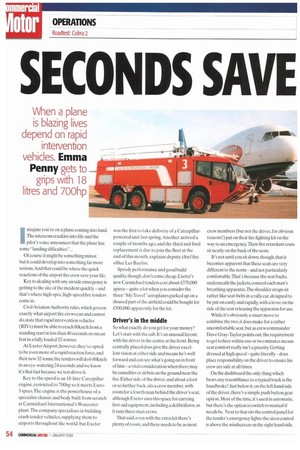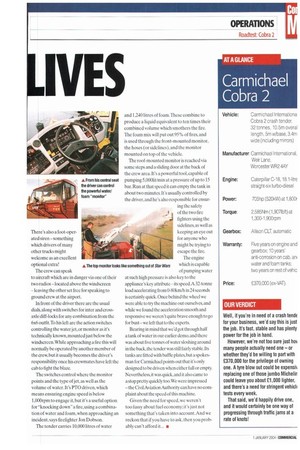SECONDS SAVE 1 VES
Page 54

Page 55

If you've noticed an error in this article please click here to report it so we can fix it.
When a plane is blazing lives depend on rapid intervention
vehicles. Emma Penny gets to
grips with 18 litres and 700hp
Imagine you're on a plane coming into land. The intercom crackles into life and the pilot's voice announces that the plane has some "landing dilliculties-...
Of course it might be something minor, but it could develop into something far more serious.And that could be where the quick reactions of the airport fire crew save your life.
Key to dealing with any airside emergency is getting to the site of the incident quickly and that's where high-spec, high-speed fire tenders come in.
Civil Aviation Authority rules, which govern exactly what airport fire crews can and cannot do. stale that rapid intervention vehicles (RIVs) must be able to reach 80km/h from a standing start in less than 40 seconds: no mean feat in a fully loaded 32-tonner.
At ExeterAirport, however, they've opted to be even more of a rapid reaction force, and their new 32-tonne fire tenders will do 0-80Iun/h in an eye-watering 24 seconds: and we know it's that fast because we test drove it.
Key to the speed is an 18-litre Caterpillar engine, restricted to 700hp so it meets Euro3 specs.The engine is the powerhouse of a specialist chassis and body built from scratch at Carmichael International's Worcester plant.'The company specialises in building crash tender vehicles, supplying them to airports throughout the world. but Exeter was the first to take delivery of a Caterpillarpowered unit last spring. Another arrived a couple of months ago, and the third and final replacement is due to join the fleet at the end of this month, explains deputy chief fire office Les Bayliss.
Speedy performance and good build quality, though. don't come cheap. Exeter's new Carmichael tenders cost about £370,000 apiece -quite a lot when you consider the three "My Travel" aeroplanes parked up on a disused part of the airfield could be bought for £500,000. apparently for the lot.
Driver's in the middle
So what exactly do you get for your money? Let's start with the cab. It's an unusual layout. with the driver in the centre at the front. Being centrally placed does give the driver excellent vision at either side and means he's well forward and can see what's going on in front of him -a vital consideration when there may be casualties or debris on the ground near the fire. Either side of the driver, and about a foot or so further back.sits a crew member. with room for a fourth man behind the driver's seat, although Exeter uses this space for carrying first-aid equipment, including a defibrillator, as it runs three-man crews.
That said.even with the extra kit there's plenty of room, and there needs to be as most crew members (but not the driver,for obvious reasons!) put on their lire fighting kit on the way to an emergency. Their fire retardant coats sit neatly on the back of the seats.
It's not until you sit down, though, that it becomes apparent that these seats are very different to the norm and not particularly comfortable.That's because the seat backs, underneath the jackets, conceal each man's breathing apparatus. The shoulder straps sit rather like seat-belts in a rally car. designed to be put on easily and rapidly, with a lever on the side of the seat releasing the apparatus for use.
While it's obviously a smart move to combine the two, it does make for a rather uncomfortable seat, but as crew commander Dave Gray-Taylor points out, the requirement to get to fires within one or two minutes means seat comfort really isn't a priority. Getting dressed at high speed -quite literally -does place responsibility on the driver to ensure his crew are safe at all times.
On the dashboard the only thing which bears any resemblance to a typical truck is the handbrake! Just below it, on the left hand side of the driver,there's a simple push button gear option. Most of the time, it's used in automatic, but there's the option to switch to manual if needs be. Next to that sits the control panel for the tender's emergency lights: the siren control is above the windscreen on the right hand side. There's also a foot-operated siren—something which drivers of many other trucks might welcome as an excellent optional extra!
The crew can speak to aircraft which are in danger via one of their two radios — located above the windscreen — leaving the other set free for speaking to ground crew at the airport.
In front of the driver there are the usual dials, along with switches for inter and crossaxle diff-locks for any combination from the 6x6 outfit.To his left are the action switches controlling the water jet, or monitor as it's technically known, mounted just below the windscreen.While approaching a fire this will normally be operated by another member of the crew, but it usually becomes the driver's responsibility once his crewmates have left the cab to fight the bla7e.
The switches control where the monitor points and the type of jet, as well as the volume of water. It's PTO driven, which means ensuring engine speed is below 1,000rpm to engage it. but it's a useful option for "knocking down" a fire, using a combination of water and foam, when approaching an incident. says firefighter Jon Dobson.
The tender carries 10,000 litres of water and 1,240 litres of foam. These combine to produce a liquid equivalent to ten times their combined volume which smothers the fire. The foam mix will put out 95% of fires, and is used through the front-mounted monitor, the hoses (or sidelines). and the monitor mounted on top of the vehicle.
The roof-mounted monitor is reached via some steps and a sliding door at the back of the crew area. It's a powerful tool.capable of pumping 5,0001it/min at a pressure of up to 15 bar. Run at that speed it can empty the tank in about two minutes. It's usually controlled by the driver.and he's also responsible for ensur ing the safety 4 , of the two fire fighters using the sidelines, as well as keeping an eye out for anyone who might be trying to escape the fire.
The engine which is capable of pumping water at such high pressure is also key to the appliance's key attribute its speed.A 32-tonne load accelerating from 0-801.m/h in 24 seconds is certainly quick. Once behind the wheel we were able to try the machine out ourselves, and while we found the acceleration smooth and responsive we weren't quite brave enough to go for bust — we left that to the experts.
Bearing in mind that we'd got through half a tank of water in our earlier clemo.and there was about five tonnes of water sloshing around in the back, the tender was still fairly stable. Its tanks are fitted with baffle plates, but a spokesman for Carmichael points out that it's only designed to be driven when either full or empty. Nevertheless, it was quick, and it also came to a stop pretty quickly too. We were impressed —the Civil Aviation Authority can have no complaint about the speed of this machine.
Given the need for speed, we weren't too fussy about fuel economy; it's j ust not something that's taken into account. And we reckon that if you have to ask, then you probably can't afford it... • A The lop monitor looks like something out of Star Wars












































































































































































